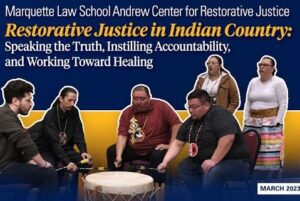 This year’s restorative justice conference was special—not only because a late-winter snowstorm seemed to have no effect on attendance, but also because it was the first annual conference to be hosted by the newly created Andrew Center for Restorative Justice at Marquette University Law School.
This year’s restorative justice conference was special—not only because a late-winter snowstorm seemed to have no effect on attendance, but also because it was the first annual conference to be hosted by the newly created Andrew Center for Restorative Justice at Marquette University Law School.
The theme for this year’s annual restorative justice conference, under the leadership of Ret. Justice Janine Geske, was Restorative Justice in Indian Country: Speaking the Truth, Instilling Accountability, and Working Toward Healing. With Native American Heritage Month now concluded, the Andrew Center would like to reflect on and draw attention to the continuing importance of our 2023 conference.
As part of this year’s conference, Justice Geske ensured that the wisdom, traditions, and voices of Native Americans would guide the conference organizing and planning. She received important early support from Marquette University’s Council on Native American Affairs. In addition, Jacqueline Schram, Director of Public Affairs and Special Assistant for Native American Affairs in the university’s Office of Institutional Diversity and Inclusion, among others, was instrumental in the conference’s success.
The conference began with a Flag Ceremony by the Mohican Veterans and a Drum Ceremony, as a sign of thanksgiving and welcome. The conference also featured speakers including Shannon Holsey, President of the Stockbridge-Munsee Band of Mohican Indians, as well as JoAnn B. Jayne, Chief Justice of the Navajo Nation. This year’s conference presented several panel discussions, which included Native American legal experts and educators who spoke and answered questions about harms suffered by Indigenous Peoples in the United States, Indigenous restorative justice practices, and restorative justice within Native American tribal law and the emergence of restorative justice within the U.S. legal system.
Perhaps more importantly, the Andrew Center hoped to encourage reflection about what restorative justice is and is not, and how it ought to be practiced in a way that is respectful to participants and the cultural ancestors of the practice. An excellent guide about restorative justice came from one of the panelists, Mark Denning, a cultural speaker and educator. “What does restorative justice look like?” asked Denning. “Victims are the focus; the harm that occurred is the second focus, and the focus on how to go about repairing that harm,” he answered. Denning also offered a contemplative question, asking: “But what’s the model: restore to what? What was it before harm was done?”
As we at the Andrew Center for Restorative Justice continue to learn more about the Indigenous roots of restorative justice, we also strive for our homepage to be a place where all may come to do the same. And so as Native American Heritage Month draws to a close, we invite you to visit our page, and to watch this year’s annual conference.
